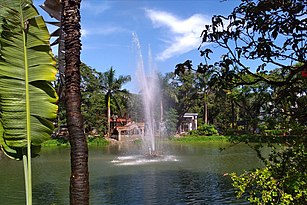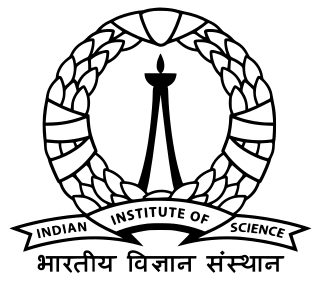
The Indian Institute of Science (IISc) is a public, deemed, research university for higher education and research in science, engineering, design, and management. It is located in the southern Indian city of Bangalore, Karnataka. The institute was established in 1909 with active support from Jamsetji Tata and thus is also locally known as the Tata Institute. It was granted a deemed university status in 1958 and recognized as an Institute of Eminence in 2018.
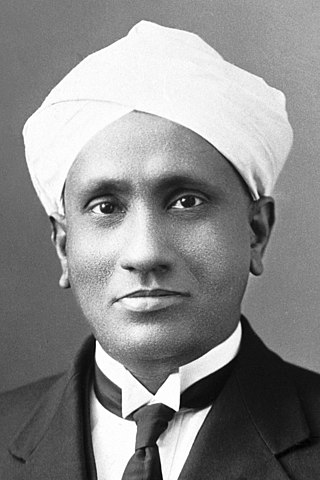
Sir Chandrasekhara Venkata Raman was an Indian physicist known for his work in the field of light scattering. Using a spectrograph that he developed, he and his student K. S. Krishnan discovered that when light traverses a transparent material, the deflected light changes its wavelength and frequency. This phenomenon, a hitherto unknown type of scattering of light, which they called "modified scattering" was subsequently termed the Raman effect or Raman scattering. Raman received the 1930 Nobel Prize in Physics for the discovery and was the first Asian to receive a Nobel Prize in any branch of science.

Sir Ashutosh Mukherjee was a prolific Bengali educator, jurist, barrister and mathematician. He was the first student to be awarded a dual degree from Calcutta University. Perhaps the most emphatic figure of Indian education, he was a man of great personality, high self-respect, courage and towering administrative ability. The second Indian Vice-Chancellor of the University of Calcutta for four consecutive two-year terms (1906–1914) and a fifth two-year term (1921–23), Mukherjee was responsible for the foundation of the Bengal Technical Institute in 1906, which was later known as Jadavpur University and the University College of Science of the Calcutta University in 1914.
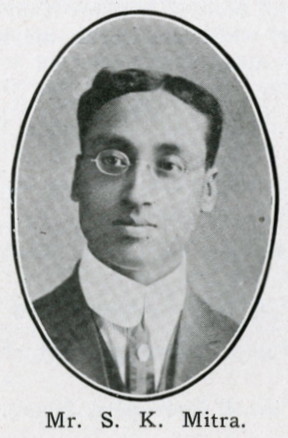
Sisir Kumar Mitra MBE, FNI, FASB, FIAS, FRS was an Indian physicist.

Sir Shanti Swarup Bhatnagar OBE, FNI, FASc, FRS, FRIC, FInstP was an Indian colloid chemist, academic and scientific administrator. The first director-general of the Council of Scientific and Industrial Research (CSIR), Bhatnagar is revered as the Father of Research Laboratories in India. He was also the first Chairman of the University Grants Commission (UGC).

Sir Kariamanikkam Srinivasa Krishnan, was an Indian physicist. He was a co-discoverer of Raman scattering, for which his mentor C. V. Raman was awarded the 1930 Nobel Prize in Physics.

Sivaramakrishna Chandrasekhar FNA, FRS was an Indian physicist who won the Royal Medal in 1994. He was the founder-president of the International Liquid Crystal Society.
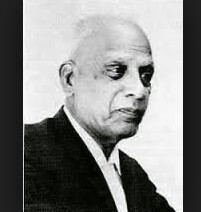
Kalpathi Ramakrishna Ramanathan was an Indian physicist and meteorologist. He was the first Director of Physical Research Laboratory, Ahmedabad. From 1954 to 1957, Ramanathan was President of the International Union of Geodesy and Geophysics (IUGG). Ramanathan was awarded Padma Bhushan in 1965 and Padma Vibhushan in 1976.
Animesh Chakravorty FNA, FASc is a Bengali Indian inorganic chemist. In 1975, he was awarded the Shanti Swarup Bhatnagar Prize for Science and Technology in chemistry by the Council of Scientific and Industrial Research.

Vinod K. Singh is a Rahula and Namita Gautam Chair Professor of Chemistry at IIT Kanpur. He is also the Director's Chair Professor at IISER Bhopal & adjunct Professor at NIPER Hyderabad. He is currently the President, Chemical Research Society of India and the Chairman, Governing Council of IACS Kolkata.

Kedareswar Banerjee was an X-ray crystallographer and director of the Indian Association for the Cultivation of Science, Kolkata. Early in his career he determined the structures of naphthalene and anthracene. In 1931, he worked with Sir William Henry Bragg and developed one of the first direct methods of crystal structure determination. He was Professor of Physics at the Indian Association for the Cultivation of Science from 1943 to 1952 and Director of the Association from 1959 until his retirement in 1965. Between 1952 and 1959 he was Head of the Department of Physics at Allahabad University. His interests in crystallography were widespread and, with his death, India has lost a renowned teacher. K. Banerjee joined the research group of Sir C. V. Raman at the Indian Association for the Cultivation of Science (IACS), Calcutta, a premier Indian research institute of India. He worked in various institutions including IACS, the India Meteorological Department, University of Dhaka and Allahabad University and finally retired as the Director of IACS, Calcutta in 1965. Prof. Banerjee explained some points of crystal research to Homi J. Bhabha also.
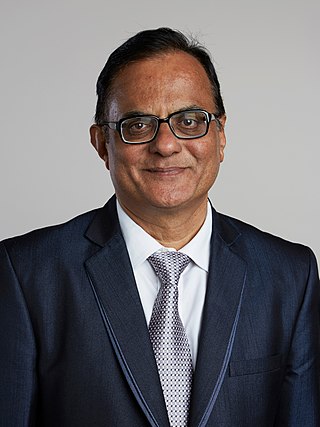
Ajay Kumar Sood is an Indian physicist and researcher currently serving as the 4th Principal Scientific Adviser to the Government of India.
Rabindranath Mukherjee also known as R N Mukherjee is an Indian former chemistry professor who is an elected fellow of the Indian National Science Academy. He was former Director of Indian Institute of Science Education and Research, Kolkata
The Chandrasekhar family is a distinguished Indian intellectual family, several of whose members achieved eminence, notably in the field of physics. Two members of the family, Sir C. V. Raman and his nephew, Subrahmanyan Chandrasekhar, were Nobel laureates in physics.
Sadhan Basu FNA, FASc, FRSC was an Indian physical chemist, academic and the Palit Professor of Chemistry at the University of Calcutta from 1964 to 1985. He was known for his elucidation of the Quantum Mechanical Model of Robert S. Mulliken. His article, Degree of Polymerization and Chain Transfer in Methyl Methacrylate, co-authored with Jyotirindra Nath Sen and Santi R. Palit was the first published Indian article on polymer chemistry. He was an elected fellow of the Royal Society of Chemistry, Chemical Society of France, Indian Chemical Society, Indian National Science Academy and the Indian Academy of Sciences. The Council of Scientific and Industrial Research, the apex agency of the Government of India for scientific research, awarded him the Shanti Swarup Bhatnagar Prize for Science and Technology, one of the highest Indian science awards, in 1962, for his contributions to chemical sciences.
Mihir Chowdhury FNA, FASc was an Indian physical chemist and Professor and Head of Department of Chemistry at Presidency College, Kolkata and at the Department of Physical Chemistry of the Indian Association for the Cultivation of Science (IACS). He is known for his studies on the electronic structure of molecules using optical, magneto-optical and quantum-mechanical methods. He was an elected fellow of the Indian National Science Academy and the Indian Academy of Sciences. The Council of Scientific and Industrial Research, the apex agency of the Government of India for scientific research, awarded him the Shanti Swarup Bhatnagar Prize for Science and Technology, one of the highest Indian science awards, in 1977, for his contributions to chemical sciences. Three of his research students were also Shanti Swarup Bhatnager awardees.
Rao BahadurSir Tiruvadi Sambasiva Iyer Venkataraman CIE, FNI, FASc was an Indian botanist, agronomist and plant geneticist who specialised in the study and hybridisation of sugarcane. He developed or supervised the development of numerous high-yield sugarcane cultivars, which established India as the world's second largest sugar producer and sustained the sugar industries of numerous other nations, including South Africa, Australia, Bangladesh, Indonesia, Pakistan, and the United States.

The University College of Science, Technology and Agriculture are two of five main campuses of the University of Calcutta (CU). The college served as the cradle of Indian Sciences by winning the Nobel Prize in Physics in 1930 and many fellowships of the Royal Society London.
Priyadaranjan Ray FNA, FIAS was an Indian inorganic chemist and historian of chemistry noted for proposing the Ray-Dutt twist mechanism.
Calamur MahadevanFNAFGMMSI, sometimes known as C. Mahadevan, was an Indian specialist in economic geology, marine geology, and nuclear geology, and 1934 Founding Fellow of the Indian Academy of Sciences, elected for Earth and Planetary Sciences, serving on the Council of the Indian Academy of Sciences from 1948 until his 1962 death. Chosen as a Fulbright scholar, with aid from the United States National Research Council, he taught at the Massachusetts Institute of Technology. Appointed to the first Professorship of Geology at Andhra University after fourteen years as Superintendent Geologist at the Geological Survey of Hyderabad, he was known as a doyen or foundational figure in the field of Indian geology.



